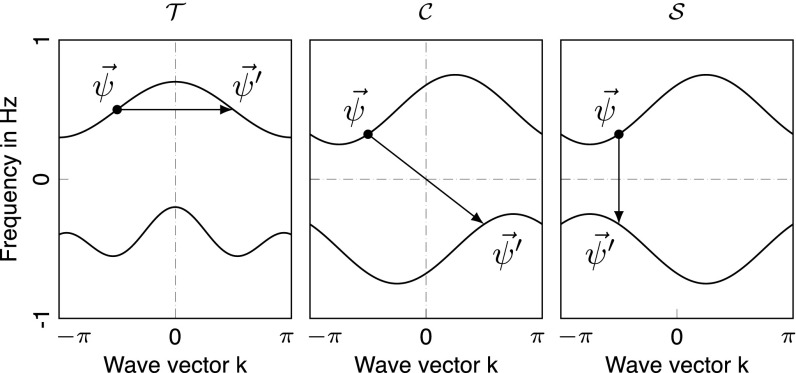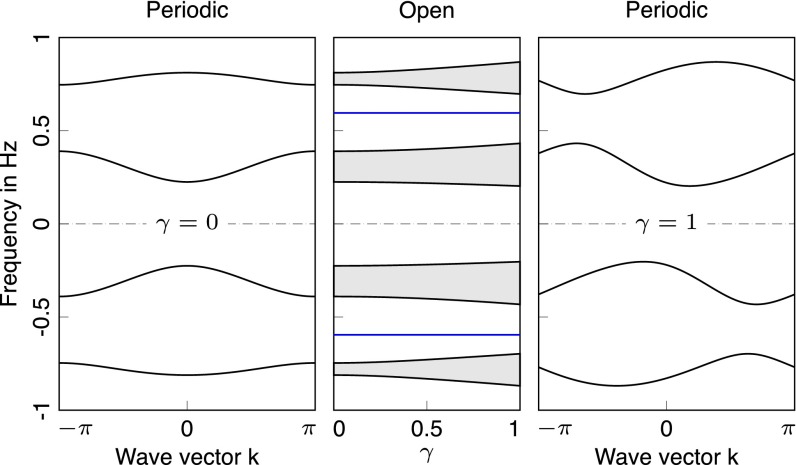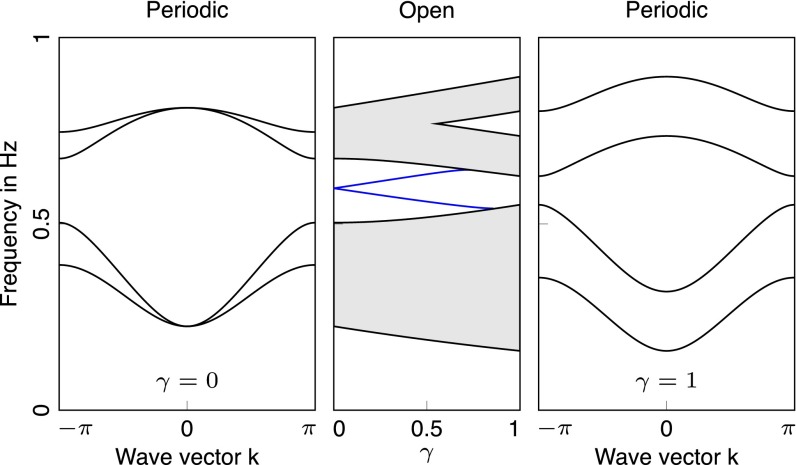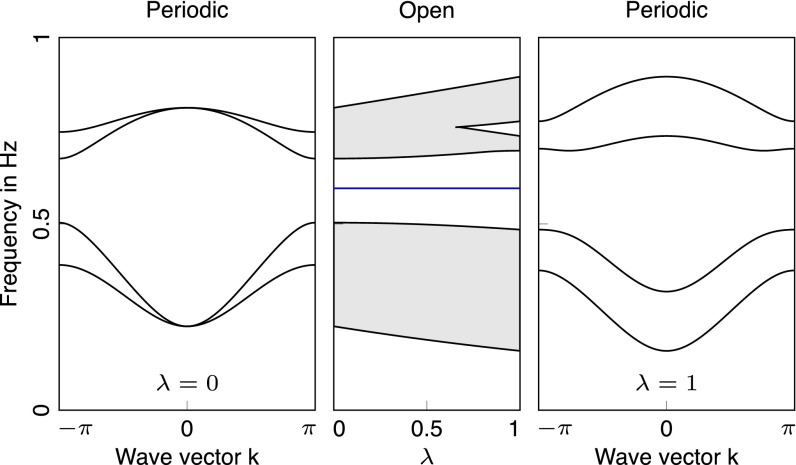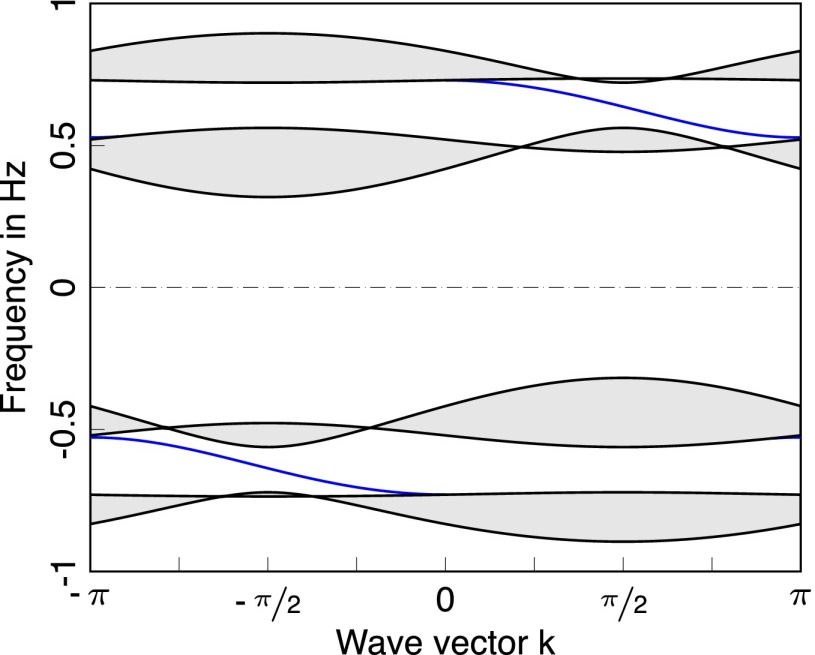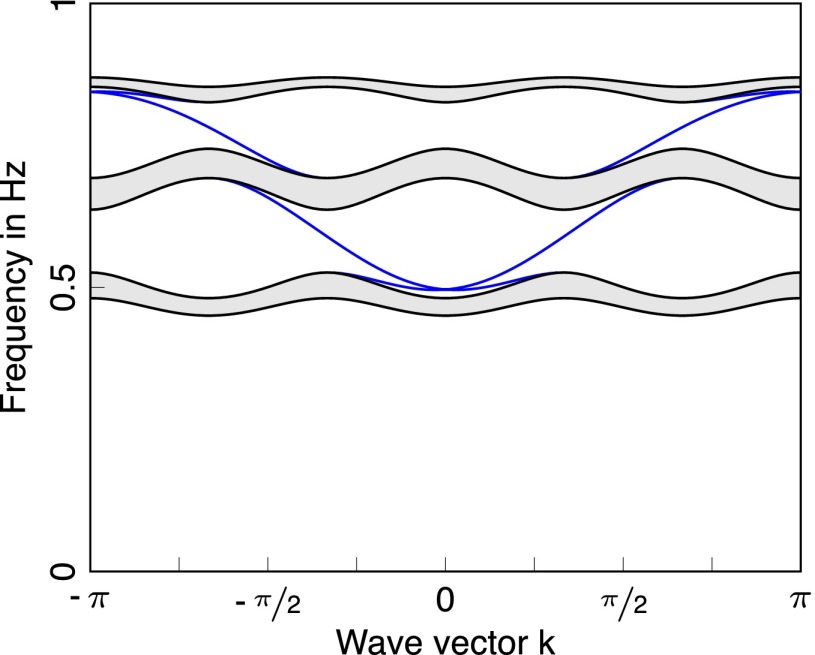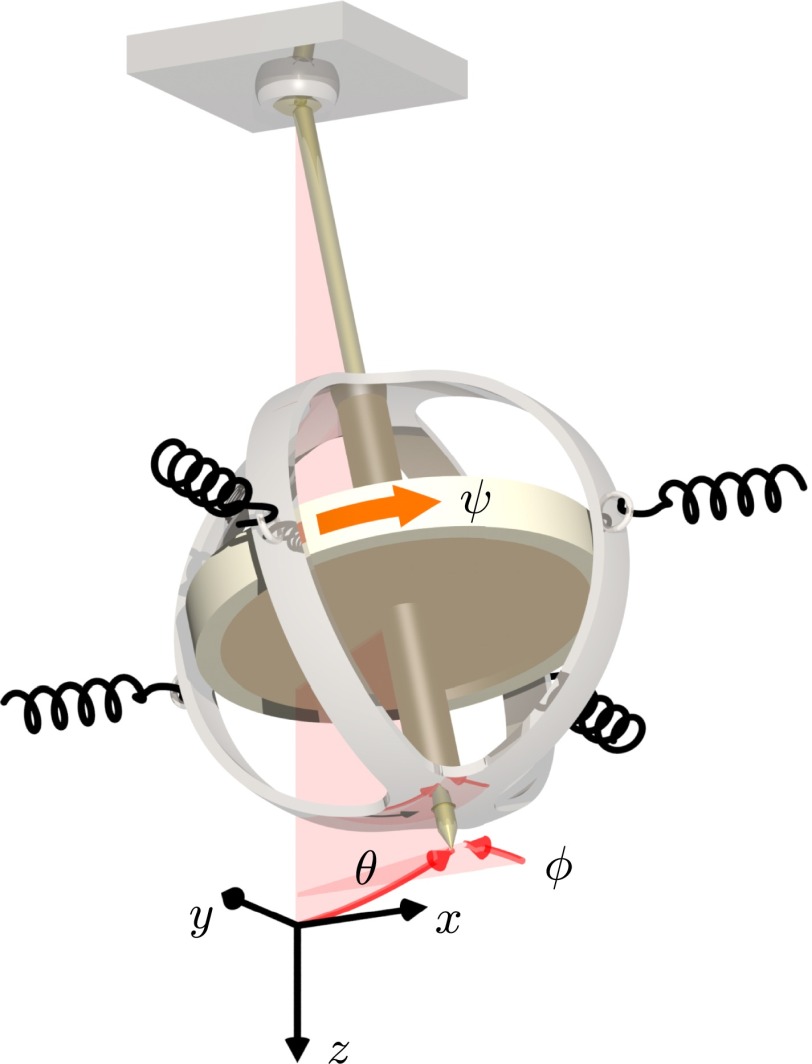Significance
A mechanical metamaterial is an engineered material that is characterized by properties that go beyond the properties of its microscopic building blocks. Specifically, in topological metamaterials, one makes use of surface or boundary modes that are stable against imperfections or environmental influences and hence constitute reliable building blocks for various applications. In our work, we provide a classification scheme of possible topological metamaterials and an extensive number of examples illustrating this scheme. Our classification can serve as an important blueprint for many future applications that target such stable boundary modes for engineering purposes.
Keywords: topological matter, mechanical metamaterials, adaptive materials
Abstract
Topological phononic crystals, alike their electronic counterparts, are characterized by a bulk–edge correspondence where the interior of a material dictates the existence of stable surface or boundary modes. In the mechanical setup, such surface modes can be used for various applications such as wave guiding, vibration isolation, or the design of static properties such as stable floppy modes where parts of a system move freely. Here, we provide a classification scheme of topological phonons based on local symmetries. We import and adapt the classification of noninteracting electron systems and embed it into the mechanical setup. Moreover, we provide an extensive set of examples that illustrate our scheme and can be used to generate models in unexplored symmetry classes. Our work unifies the vast recent literature on topological phonons and paves the way to future applications of topological surface modes in mechanical metamaterials.
Mechanical metamaterials derive their properties not from their microscopic composition but rather through a clever engineering of their structure at larger scales (1). Various design principles have been put forward and successfully applied in the past. Examples range from periodic modifications leading to band gaps via Bragg scattering (2) to the use of local resonances (3) to achieve subwavelength functionalities. Recently, the concept of “band topology” emerged as a new design principle for mechanical metamaterials (4–14). Colloquially speaking, a system with a topological phonon band structure will possess mechanical modes bound to surfaces or lattice defects that are immune to a large class of perturbations. If the targeted purpose of a metamaterial is encoded in such a topologically protected mode, its functioning will be largely independent of production imperfections or environmental influences.
The introduction of topology to the field of mechanical metamaterials was largely motivated by its successful application to the description of electrons in solids (15) and to photonics (16–19). One of the key elements in the understanding of the electronic systems was the classification of different topological phases according to their symmetry properties (20–22). Although over the last years numerous proposals (4, 5, 23–42) and several experiments (6–14) were put forward promoting mechanical topological metamaterials, a complete classification of linear topological phonons is missing to date. In this report, we intend to fill in this gap.
At first sight, the dynamics in classical mechanics seems to be rather different from quantum-mechanical electron systems. Our approach is therefore to map the first to the second problem (26). This, in principle, allows us to import the classification (20, 21) from the description of electronic systems. However, a bare import of this classification is not doing justice to the rich structure mechanical systems possess by themselves.
We can categorize mechanical metamaterials by two independent properties. First, the targeted functionality can either be at zero or at finite frequencies. Zero-frequency modes define structural properties such as mechanisms where parts of a material move freely (5, 8). The dual partners of freely moving parts are states of self-stress (35), where external loads on a material can be absorbed in the region of a topological boundary mode. Defining such details of the load-bearing properties of a material are relevant both for smart adaptive materials (9) as well as for civil engineering applications. The design of finite-frequency properties, on the other hand, constitutes a quite different field of research. Here, the goals are to control the propagation, reflection, or absorption of mechanical vibrations. This includes, for example, waveguiding, acoustic cloaking, or vibration isolation ranging from the seismic all of the way to the radiofrequency scale.
A second important separation into two distinct classes of materials arises from the presence or absence of nonreciprocal elements (43). Generically, nondissipative mechanical properties are invariant under the reversal of the arrow of time. Nonreciprocal elements, however, transmit waves asymmetrically between different points in space. The absence of time-reversal symmetry allows for a topological invariant, the Chern number, which encodes chiral, or unidirectional wave propagation. We will see that these two attributes: static vs. dynamic and reciprocal vs. nonreciprocal will be key to understand how the electronic classification is naturally modified for mechanical systems.
Before we embark on the development of the framework needed for our classification, let us state our goals more precisely. Our aim is to import and adapt the classification of noninteracting electron systems according to their local symmetries , , and , that is, time reversal, charge conjugation, and their combination, respectively (20, 21). Clearly, we will have to specify the role of these symmetries in mechanical systems. Moreover, we cover only the “strong” indices, which do not rely on any spatial symmetries. The extension to weak indices, arising from a stacking of lower-dimensional systems carrying strong indices, is straightforward (5). Finally, there are many recent developments dealing with topological phases stabilized by spatial properties (44–48) such as point group symmetries. Although such spatial symmetries are more easily broken by disorder, the required ingredients might be very well tailored to the mechanical setup (49, 50).
The remainder of this paper is organized as follows: we start by developing a framework to map classical problems to an equation that formally looks like a Schrödinger equation of a quantum-mechanical problem. We then introduce the three symmetries, , , and , and discuss their appearance in mechanical problems before we provide the sought classification. Finally, an extensive example section serves two purposes: we illustrate and apply our approach. Moreover, we show a way how to construct new symmetry classes from generic building blocks.
Models and Theoretical Framework
In this manuscript, we aim at characterizing discrete systems of undamped, linear mechanical oscillators. Although this setup is directly relevant for simple mass-spring systems (11) or magnetically coupled gyroscopes (12), the scope here is actually considerably broader. Any system that can be reliably reduced to a discrete linear model is amenable to our treatment. This includes 1D (40), 2D (25, 38, 39, 41), or 3D (40) systems made from continuous media, where a targeted microstructuring enables the description in terms of a discrete model. Once we deal with a discrete model, we have a direct way to import the methods known from electronic topological insulators. To establish this bridge, we now introduce a formal mapping of a classical system of coupled oscillators to a tight-binding hopping problem of electrons in solids.
We start with the equations of motion of a generalized mass-spring model given by
| [1] |
Here, t denotes time; , one of the N independent displacements; and , its time derivative. The mass terms are absorbed into the real and constant coupling elements and . The entries can be thought of as springs coupling different degrees of freedom, and arise from velocity-dependent forces. Note, that a nonzero implies terms formally equivalent to the Lorentz force of charged particles in a magnetic field and hence arise only in metamaterials with nonreciprocal elements. In addition to constant coupling elements in 1, one can also consider periodically driven systems. Such driven system can be cast into our framework by a suitable (Magnus) expansion of the corresponding Floquet operator (37, 51, 52).
We aim at rewriting Eq. 1 in the form of a Schrödinger equation, or rather as a Hermitian eigenvalue problem. Therefore, we need the system to be conservative (nondissipative). This is achieved by requiring D to be symmetric positive-definite and to be skew-symmetric.‡
An eigenvalue problem emerges from Eq. 1 via the ansatz :
| [2] |
where we gathered the indices i in a vector notation . Energy conservation requires all eigenvalues λ to be real, but the ansatz renders the problem complex. However, a suitable superposition of complex eigensolutions always allows to create real solutions with .
Although Eq. 2 contains all of the information about the eigensolutions, for the topological classification it is advantageous to transform it into a Hermitian form. To this end, we apply the transformation
| [3] |
to . The square root of the matrix D is defined through its spectral decomposition, where the positive branch of the square root of the eigenvalues is chosen. With this, we arrive at
| [4] |
As D is symmetric positive-definite and is skew-symmetric, the matrix H is Hermitian and the differential equation for has the sought-after form of a Schrödinger equation.
The formulation in Eq. 4 is reminiscent of a single-particle tight-binding problem in quantum mechanics. Therefore, the discussion of topological properties of the eigenvectors can be directly carried over. Remember that the topological classification is based on the spatial dimensionality of the problem as well as properties of special local symmetries alone. In particular, the topological properties do not rely on translational symmetries. However, their discussion and definitions are most conveniently introduced for translationally symmetric systems. In this case, the D and matrices are periodic and a spatial Fourier transform block-diagonalizes them (one block for each wave vector ). It follows that becomes block diagonal as well, because it shares its eigenvectors with D. Hence, we will discuss families of Hamiltonians of the form 4.
Before turning our attention to the topological classification, we comment on two more points: (i) the influence of damping and (ii) the possibility for alternative Hermitian forms. Every real system is prone to damping, which in turn affects the eigensolutions in two ways. The eigenvalues acquire an imaginary part and the form of the eigenvectors may change. Although a slight change of the eigenvalues does not influence the subsequent discussion, the difference in the eigenvectors may alter the results. Whether or not it obstructs the use or observation of a given topological effect depends on the details of the specific system.
Now to the second point. The transformation leading to Eq. 4 is not the only way to introduce a Hermitian problem. In fact, any decomposition of the form , will allow us to achieve this goal. By introducing the auxiliary variables , we may express Eq. 1 as
| [5] |
The particular choice has the advantage that (i) has the same eigenvectors as D, (ii) it uses only as many auxiliary degrees of freedom as needed, (iii) it allows to directly block-diagonalize the problem in absence of , and (iv) it offers a canonical way how to choose Q.
Nevertheless, this is not the only useful choice of Q. The starting point for our choice was a given D and , originating from an effective model. In certain cases, however, there is a natural choice of Q along with a physical meaning. Such cases have been considered by Kane and Lubensky (5, 35). In their setup the matrix Q corresponds to the equilibrium matrix of a mass-spring model, where Q relates spring tensions to displacements of the attached masses. This allows for a beautiful discussion of (topological) states of self-stress in isostatic lattices (5, 35). Although such states of self-stress elude our description, the formulation of Kane and Lubensky is only applicable to the restricted set of isostatic models, which makes it not the favorite choice for the purpose of our discussion.
Symmetries
As mentioned before, the classification of electronic systems is based on three symmetries: time-reversal symmetry , particle-hole symmetry , and chiral symmetry . In the quantum-mechanical case, these symmetries are represented by (anti)unitary operators on the single-particle Hilbert space. For the present context of classical mechanical systems, it is important to note that these symmetries are merely a set of constraints on the Bloch Hamiltonians (21). We state here the form of these constraints and discuss their relation to natural symmetries of mechanical systems below.
We call a system symmetric if
| [6] |
for some antiunitary , which represents . For the particle-hole symmetry , the respective criterion is
| [7] |
with antiunitary. Finally, the chiral symmetry , we demand
| [8] |
for a unitary (Fig. 1).
Fig. 1.
Visualization of , , and symmetries by three prototypical band structures. The presence of a symmetry implies a certain symmetry in the band structure (but not the other way around) (see text).
For a generic Hilbert space , there are no additional restrictions on the representations U, but here the “Hilbert space” has additional structure. Any eigenvector is of the form . Hence, after fixing the first half of the entries of , the remaining half is known as well. It follows that any (anti)unitary mapping can be written as
| [9] |
with V and W (anti)unitary. Let us have a closer look at the three symmetries 6–8 within this framework.
From the definitions, it follows that H has symmetry if and only if we can find V, such that
| [10] |
with . We refer to it as symmetry, instead of “time reversal,” because in the setting of classical mechanics it does no longer correspond to the reversal of time. In general, the presence of symmetry relies on fine-tuning of parameters, whereas in case that there is a generic symmetry:
| [11] |
where κ is the complex conjugation operator. Note that, even though has the potential to break symmetry, does not imply the absence of it.
For symmetry, the conditions to be satisfied are
| [12] |
with . Therefore, for any D and , we can find a particle-hole symmetry
| [13] |
The existence of this omnipresent particle-hole symmetry is nothing but the statement that, for every eigensolution, its complex conjugate is also an eigensolution. Its presence is based on D and being real.
In case we have and particle-hole symmetry, we can combine the two to obtain a unitary operator . This unitary operator represents a chiral symmetry. We can therefore conclude that, if , we always have a chiral symmetry
| [14] |
This symmetry is nothing but classical time-reversal symmetry, as every eigenvector is mapped to itself and the corresponding eigenvalue becomes minus itself.
So far, particle-hole and chiral symmetries were defined with respect to , meaning that an eigensolution is related to an eigensolution with (Fig. 1). However, for the purpose of topological indices, we can weaken this requirement. A potentially -dependent shift in ω does not change the form of the eigenvectors. Hence, it is sufficient to require the right-hand side of Eqs. 7 and 8 to equal to instead of zero. Furthermore, particle-hole and chiral symmetries can also exist only on parts of the band structure, which means that it is possible to have these symmetries on a subspace of all of the solutions only.
These two generalizations of and symmetries arise naturally in the setting of mass-spring models.§ Assume that D, which is a real, symmetric matrix and therefore Hermitian, has a particle-hole symmetry with respect to , and that . Then, all of the eigenvectors of H with positive eigenvalue have a particle-hole symmetry with respect to some , whereas all of the eigenvectors of H with negative eigenvalue have one with respect to . The matrix can be made block-diagonal with the two blocks and each corresponding subspace of solutions has a particle-hole (and chiral) symmetry with respect to .
After discussing the above symmetries, we have all elements we need to establish a topological classification of generic mechanical systems.
Classification
With the mapping of the equations of motion to a Hermitian eigenvalue problem, we can in principle directly use the classification scheme of noninteracting electron systems (20, 21). However, the specific properties of the local symmetries discussed above warrant a more careful discussion. To make further progress, we highlight the most important concepts behind the electronic classification. For a more detailed review, we refer the reader to the excellent recent review by Chiu et al. (53). A reader not interested in the details of the derivation might jump straight to Tables 1–4 for a reference of possible topological phonon systems and the example section for an illustration of these tables.
Table 1.
The 10-fold way
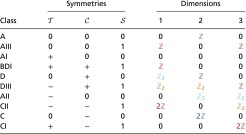 |
The color code is explained in the main text. This table also applies to the high-frequency problem of nonreciprocal metamaterials. The first column gives the standard names of the symmetry groups. The next three columns serve to indicate the absence (0) or presence () of a given symmetry. The signal that the respective symmetry squares to . The last columns finally provide the information if the band structures in the given dimension is characterized by an integer number (), an even integer (), or a binary index ().
Table 4.
Indices for low-frequency nonreciprocal metamaterials with
 |
Here, only the symmetry needs to be augmented as no generic symmetry is present.
For noninteracting electrons, the ground state is given by a Slater determinant of all states below the chemical potential. The topological properties are then encoded in the projector onto the filled bands. Moreover, one can simplify the discussion by introducing a “flattened Hamiltonian” , which assumes the eigenvalues for filled (empty) bands (53).
The topological indices are now encoded in the mappings from the Brillouin zone to an appropriate target space induced by . In the absence of any symmetries the target space are the set of complex Grassmanians. In even dimensions, these mappings are characterized by Chern numbers that lie in (marked in blue in Table 1). In case that the chiral symmetry is present, the matrices have additional structure. This structure can be used to block–off-diagonalize them (21, 53)
| [15] |
and to obtain a mapping from the Brillouin zone to the space of unitary matrices. In odd dimensions, the homotopy group of these maps is described by a winding number (marked in red in Table 1). These two types of indices are called the primary indices.
Additional indices can be derived from the primary ones when more symmetries are present. By constructing families of - and -dimensional systems whose interpolation constitute a d-dimensional Hamiltonian with a primary index, one can establish topologically distinct families of such lower-dimensional band structures through descendant indices. They are marked in light blue (light red) for descendants of the Chern (winding) numbers. Moreover, certain symmetries restrict the primary indices to even values denoted by in Table 1. Concrete formulas for the Chern and winding numbers are given in Supporting Information. For general formulas for the descendent indices, we refer to ref. 53 and references therein. This overview concludes our discussion of the electronic classification, which is summarized in Table 1.
For mechanical systems, a few characteristics deserve special attention. First, in a mechanical system, no Pauli principle is available to give a band as a whole a thermodynamic relevance. However, it is clear that the projector to a given number of isolated bands encodes the topological properties of the (high-frequency)¶ gap above these bands. For engineering applications in the respective frequency range, this is good enough. Second, before we apply the topological classification of Table 1 blindly to a generic mechanical system it is beneficial to first structure the problems at hand by “nontopological” considerations.
There are two natural properties that divide the mechanical problems into four different classes: (i) a mechanical system can either be made from “passive” building blocks, or it can incorporate nonreciprocal elements. In our formulation, they distinguish themselves by the absence or presence of a term in the Hamiltonian 4. (ii) The formulation of topological indices is rather different for the case where we target the gap around (relevant for thermodynamic or ground-state properties) or a gap at finite frequencies. In the following, we discuss the different combinations of finite vs. zero frequency and reciprocal vs. nonreciprocal materials separately.
High-Frequency Nonreciprocal Metamaterials.
The presence of puts the high-frequency problem of nonreciprocal metamaterials on equal footing with the electronic problem. Therefore, no further constraints are imposed and the full Table 1 is explorable.
High-Frequency Reciprocal Metamaterials.
For reciprocal high-frequency problems, one can in principle apply the classification scheme to D rather than H, as already D is a Hermitian matrix.# The reality of D ensures the presence of a symmetry that squares to . One can augment this symmetry to an antiunitary symmetry that squares to via an appropriate unitary symmetry :
| [16] |
However, it is important to note that the simultaneous presence of both a and symmetry will force certain indices to vanish. A careful but straightforward analysis (Supporting Information) of the indices results in Table 2 relevant for reciprocal high-frequency problems.
Table 2.
Indices for high-frequency reciprocal metamaterials with
 |
There is always a symmetry squaring to , which can be augmented to squaring to .
Low-Frequency Reciprocal Metamaterials.
Topological band structures with nontrivial gaps around zero frequency are relevant for floppy modes in static problems (8) or thermodynamic properties (34) of jammed granular media. As argued above, the structure of the equations of motion imply a symmetry around . In the absence of , an additional symmetry is present. Both this built-in symmetries canonically square to . As in the case of high-frequency reciprocal materials, one can augment these symmetries by unitary symmetries to reach classes where the augmented ones square to . Table 3 summarizes the resulting possibilities for topological indices in this setup.
Table 3.
Indices for low-frequency reciprocal metamaterials with
 |
Both the and symmetry need to be augmented to reach classes where these symmetries square to .
Low-Frequency Nonreciprocal Metamaterials.
Similarly to the high-frequency nonreciprocal metamaterials, the generic symmetry is absent here. Hence, there can arise effective symmetries that either square to or without the need to augment the generically present one to reach classes where . Given that we deal with the gap at , however, guarantees the generic symmetry, which in turn can be enriched to one that squares to . The resulting possible topologies are shown in Table 4.
For the case of zero-frequency indices, the construction of H with the help of necessary leads to trivial phases (Supporting Information). However, in refs. 5 and 35, it was shown how a decomposition allowing for nontrivial indices in class BDI can be constructed for Maxwell frames. How one can construct similar formulations for the other symmetry classes shown in Tables 3 and 4 is an interesting open problem.
Examples
To clarify and reinforce our approach, we provide a set of examples. We directly consider discrete models. An example on how to extract a discrete description of a continuum model is provided in Supporting Information. The degrees of freedom are assumed to be ideal 1D or 2D pendula. The desired D matrix can be obtained by coupling the different pendula by springs. To encode negative coupling elements, or in case of geometrical obstructions, it might be required to replace a spring coupling by a more involved coupling composed of springs and deflection levers, as for example, in ref. 11. Note, that although we consider pendula as our local oscillator, all examples are generic and can be applied to any set of mechanical modes.
The last ingredient we need is a . One option is to engage the Lorentz force, which directly provides such a coupling. Another possibility is to use spinning tops, or gyroscopes as in refs. 12 and 30. We consider a symmetric gyroscope with a fixed point (different from the center of mass) about which it can rotate (Fig. 2). For our considerations, there will be no external moment along the principal axis passing through the center of mass, rendering this rotation a conserved quantity. Hence, there are only two degrees of freedom left.
Fig. 2.
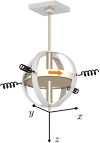
Coordinate system for a spinning gyroscope.
In a constant gravitational field, we can use the direction of the field to define a z axis. The potential energy of the gyroscope has a minimum, and one can linearize the problem about this minimum. The resulting problem has two effective degrees of freedom, which we choose to be displacements along the x and y direction. The equation of motion for the linearized system is then of the form (Supporting Information)
where γ is proportional to the spinning speed of the gyroscope and are external moments coupling to it. Such moments arise, for example, from the couplings to neighboring degrees of freedom. For multiple gyroscopes, this allows us to obtain
| [17] |
These are all elements we need to discuss the following examples. Although every model has a high-frequency and a low-frequency symmetry part, we are only looking at the former, where the generic particle-hole symmetry is irrelevant. For a detailed discussion of certain low-frequency models, we refer to refs. 5 and 35.
We start with the simplest possible 1D model with a nontrivial index below. After its discussion, we show how one can combine several copies of such simple building blocks to reach a number of other symmetry classes in 1D. Finally, we provide each an example of a 2D system with a nonvanishing Chern number and a model where we use the idea of symmetry enrichment.
Class BDI in 1D.
Probably the simplest model available is the analog of the Su–Schrieffer–Heeger model (54). It can be realized through a chain of 1D pendula, coupled through springs with alternating spring constants t and . Its dynamics is governed by
| [18] |
and for positive definiteness.
The model has a symmetry (chiral symmetry), which can already be seen on the level of the D matrix:
The symmetry translates into a symmetry of , which are the two blocks of after block-diagonalizing it:
| [19] |
In addition, the model has symmetry and therefore symmetry as well, which puts it into symmetry class BDI. This class features a winding number through its matrix
| [20] |
with . The matrix is already in block–off-diagonal form, and hence, the winding number is given by (Supporting Information)
The band structure of the periodic system is shown in Fig. 3, Left, and the eigenfrequencies of the open system are given in Fig. 3, Middle, at the point (see below). Up to here, we were free to discuss the problem in terms of instead of . However, this is no longer possible once , as considered in the next example.
Fig. 3.
Spectra of examples belonging to classes BDI () and AIII (). (Left) The band structure of the BDI model given in Eq. 18. (Middle) Spectrum of an open AIII chain as a function of γ. Blue lines denote edge modes, whereas the gray areas represent the bulk modes. (Right) The band structure of the AIII model for . Parameters chosen to obtain the figures are: , , and .
Class AIII in 1D.
The above model is now supplemented by a nonvanishing matrix. This breaks the and the particle-hole symmetry, but the chiral symmetries on the two subspaces (positive/negative eigenfrequencies) are left invariant. In the case that , all spectral gaps remain open, and hence the topological index will not change. The evolution of the gap as well as of the edge mode (which stays invariant) for increasing γ is shown in Fig. 3, Middle. An exemplary band structure for can be seen in Fig. 3, Right.
Breaking and symmetry of the BDI model did not change the topological index, because the index relies on chiral symmetry only.
Class D in 1D.
To break the symmetry while keeping symmetry, we need to add further degrees of freedom. Starting point are two copies, and , of the above BDI model:
| [21] |
We assume that both share the same μ. For , the model belongs to BDI and the winding number of the lowest two bands is given by
By choosing or , and turning on , we break all of the symmetries except for the high-frequency symmetry
This puts the model into symmetry class D.
The index gets reduced to a index,
the parity of the winding number. In the case that , the breaking of the symmetry makes the cases and equivalent, as the two edge modes can hybridize and disappear from the gap (Fig. 4). In the case that , the single-edge mode from the BDI model remains as displayed in Fig. 5.
Fig. 4.
Spectra of examples belonging to classes BDI () and D (trivial) (). (Left) The band structure of the periodic BDI model given in Eq. 21. (Middle) Spectrum of the open D model. The parity of the winding number is even; therefore, the topological edge modes are not protected upon turning on . (Right) The band structure of the D model for . Parameters chosen to obtain the figures are: , , , , and .
Fig. 5.
Spectra of examples belonging to classes BDI () and D (nontrivial) (). Here, the parity of the winding number is odd, and hence the topological edge mode is protected even when . Parameters chosen to obtain the figures are: , , , , and .
Class A in 2D.
The topology of the discussed 1D models relied on the presence of a () symmetry. The next model we look at does not rely on any symmetries at all, and the topological index will be the Chern number. To obtain a nonvanishing Chern number, we need to break symmetry by choosing , and therefore we need to have at least two degrees of freedom per unit cell. The matrix can only take the form from Eq. 17, which leaves us with finding a suitable D matrix.
To this end, it is helpful to transform , as in Eq. 19, to
and to define
| [22] |
By varying , we can continuously deform into a model with two decoupled blocks . If the bulk gaps remain opened during the interpolation from to , the Chern number of any subspace will not change, and we can focus on constructing nontrivial subblocks of .
We now focus on the block characterized by . This matrix is Hermitian and can be written as
where are the Pauli matrices
and , a vector with real coefficients. The d vector contains all of the information about the eigensolutions of the problem and therefore also about the Chern numbers of the bands. In the case that for all and , we can define . Upon varying and through the Brillouin zone traces out a closed surface in . It can be shown that the number of net encircling of the origin by this surface corresponds to the Chern number of the lower band (55).
A possible choice of coefficients giving rise to a nontrivial band structure is
| [23] |
Owing to the fact that and D share the same eigenvalues, it is easy to see that the dynamical matrix is parameterized by
| [24] |
for some suitable and t.
The approximative argument at is supported by a numerical calculation for , which confirms the presence of a nonzero Chern number. In addition, we show the spectrum of a semiinfinite cylinder in Fig. 6, revealing the existence of an edge mode within the bulk gap.
Fig. 6.
Spectrum of the class A model on a semiinfinite cylinder as a function of the wave vector around the cylinder. Gray areas represent a continuum of bulk modes, whereas blue lines denote the chiral surface modes. Parameters chosen to obtain the figure are: , , and .
The presented model is a minimal model in the sense of required degrees of freedom. However, it is probably not the simplest model for an actual implementation. For such a purpose, a simpler model can be found in ref. 12.
Class AII in 2D.
Up to here, all examples we looked at were based on symmetries that square to . However, we can also supplement symmetries to obtain new symmetries that can square to . As an example, we discuss the quantum spin Hall-like system presented in ref. 11. It mimics a Hofstadter model (56) at flux plus its time-reversed copy. Its dynamical matrix is
and .
The structure of carries a symmetry whose antiunitary representation is just given by the complex conjugation κ, that is, . Therefore, this symmetry squares to 1. However, there is an additional structure, which allows to generate an augmented symmetry ,
which gets lifted to a symmetry of . Otherwise, there are no relevant symmetries present away from , which puts the problem into symmetry class AII. Repeating the calculation from the previous model results in Fig. 7. For further details on this model, we refer directly to ref. 11.
Fig. 7.
Spectrum of the class AII model on a semiinfinite cylinder as a function of the wave vector around the cylinder. Parameters chosen to obtain the figure are: and .
Conclusions
In summary, we have developed a framework to map the equations of motion of a set of coupled linear mechanical oscillators to a quantum-mechanical tight-binding problem. Using this mapping, we showed how one can import the topological classification of noninteracting electron systems to the realm of classical mechanical metamaterials. Using the presence or absence of nonreciprocal elements as a key aspect of metamaterials, we further adapted the electronic classification to mechanical problems.
With our work, we provide the stage for the development of potentially new classes of materials, where topological boundary modes can be used to provide a specific functionality. Moreover, we help to clarify the recent literature in the field, where topological phonon modes have been predicted without an overarching framework. We hope that, with the extensive example section, we provided the reader with the tools and concepts to construct more topological phonon models using simple building blocks.
Many directions in the field of topological mechanical metamaterials are still unexplored. Obvious problems to be solved are the presentation of a topological surface mode in a 2D or 3D continuous material or the miniaturization of the effects observed at the centimeter scale down to micrometer scale. Moreover, examples of materials in many of the possible symmetry classes characterized in this report have neither been theoretically proposed nor experimentally implemented. We hope that, with this work, we stimulate research in this direction. Moreover, our results also provide the framework to import ideas based on crystalline symmetries.
Finally, the efficient characterization of model materials according to their topological properties is an important open problem. In electronic systems, the search for topological band structures is now routinely done using high-throughput ab initio calculations in combination with advanced numerical tools (57) to determine the topological indices. Our framework should provide the basis for a similar approach in mechanical metamaterials and therefore open the route to various applications based on topological boundary modes.
Example on How to Obtain Topological Indices
As promised, we provide formulas for the primary indices in 1D, 2D, and 3D. The Chern number in 2D as a functional of Q is given by (53)
| [S1] |
The winding number in odd dimensions is given by (21)
| [S2] |
in 1D, and
| [S3] |
in 3D. These two expressions can be unified using the winding number density
| [S4] |
yielding
| [S5] |
Using these expressions for the winding number, we now argue how a combined presence of () symmetries squaring to and leads to the vanishing of certain indices. Let us introduce the notation for the “signature” of the symmetry class , with denoting that the respective symmetries square to . Different signatures dictate different constraints on the winding number density.
Let us start with . Here, we have (21, 22)
| [S6] |
giving rise to the constraint
| [S7] |
for the winding number density. This leads to a vanishing winding number in 1D. For , one finds (21, 22)
| [S8] |
which in turn leads to
| [S9] |
This results in a vanishing winding number in 3D. For cases in which we have two signatures, for example, and , due to the enrichment of the symmetry by a unitary symmetry to a symmetry (see main text), both constraints apply and one loses additional indices.
Low-Frequency Physics in Class BDI
Materials in class BDI carry a index as topological classification. For the low-frequency physics, this index can, for example, be relevant for states of self-stress (5, 35). However, if we choose , these states are not accessible, and we find that the index is always trivial, which can be seen from the following explicit calculation.
To proof this claim, we start from . In this case, the H matrix is given by
| [S10] |
and the eigenfunctions can be found to be
| [S11] |
The projector onto the negative bands is therefore given by
| [S12] |
and the Q matrix is obtained to be
| [S13] |
This Q matrix has a trivial index, which concludes the proof in case . The general statement for arbitrary follows from the fact that cannot close the spectral gap at , and therefore cannot change the index, as shown next.
We show below that cannot induce a gap closing at , that is, if there is a gap for some value of , there will be a gap for any . A gap closing at requires at least one eigensolution of H with an eigenvalue equal to zero, or equivalently, we need
| [S14] |
From
| [S15] |
together with
| [S16] |
we find
| [S17] |
where the second equality follows from Laplace’s formula. This shows that the determinant in S14 is independent of , which proofs the statement.
Linearized Equations of Motion of a Gyroscope
We intend to describe the motion of the gyroscope close to its potential minimum, such that the motion of the tip can be described by two Cartesian coordinates x and y. To give a general expression for the Lagrangian of the gyroscope, we start from a description in Euler angles θ, ϕ, and ψ, such that
| [S18] |
and ψ describes the rotation with respect to the axis through the center of mass (Fig. S1).
Fig. S1.
Coordinate systems for a spinning gyroscope.
In terms of the principal axis of the gyroscope, its Lagrangian is given by
| [S19] |
where V denotes potential energy due to gravity and couplings to neighboring gyroscopes. are the angular velocities with respect to the principle axes, and , the corresponding moments of inertia. The gyroscope is assumed to be symmetric, such that and is associated with the rotation with respect to the axis through the center of mass. In Euler angles, the Lagrangian takes the form
| [S20] |
In the case that , which is the case we consider, the Euler–Lagrange equation for ψ reads
| [S21] |
and we find the conserved quantity .
The remaining Euler–Lagrange equations are, for the variable θ,
| [S22] |
and, for ϕ,
| [S23] |
In these two equations, we change variables to x and y, make use of , and make a lowest-order expansion in x and y. As a result, the equation for ϕ becomes
| [S24] |
whereas, for the one of θ, we find
| [S25] |
We can further simplify these equations by adding x times Eq. S24 to y times Eq. S25 to obtain
| [S26] |
Similarly, by subtracting y times Eq. S24 from x times Eq. S25, we find
| [S27] |
These last two equations can be summed up as
| [S28] |
which is the desired form as used in the main part of the paper.
Example for the Simplification of a Continuum Model
Our approach is not restricted to discrete systems. In the following, we give a simple example on how it can be applied to a continuum model. The example is based on ref. 10, where such a reduction was performed, and we discuss how it can be cast into our classification. The system consists of a chain of dumbbell-shaped elements, arranged in a periodic array along the axis of the dumbbells. For the details of the setup, please directly consult ref. 10.
The collective behavior of the full system can be understood from a constructional point of view. Each unit cell has its eigenmodes, which get coupled to the eigenmodes of the neighboring unit cell. In general, couplings between all neighboring modes need to be considered to understand the collective behavior of the full system such as its band structure. However, parts of the band structure can typically already be understood by taking only a few local modes into account. By an apt choice of the geometry of the unit cell (10), one can obtain a band structure that effectively has only two bands at around kHz, and these two bands originate from two local modes only. Hence, if we are only interested in these two bands, we can reduce the full problem to a discrete model with only two modes per unit cell. The most general form of the D matrix is then given by
| [S29] |
where is the vector of Pauli matrices.
The exact coefficients depend on the details of the implementation. Nevertheless, the structure of them can already be deduced from the symmetry properties of the modes and their couplings. As it turns out, one of the two modes is symmetric along the axis, whereas the other mode is antisymmetric. The two modes have different eigenfrequencies and every symmetric (antisymmetric) mode couples to its two adjacent symmetric (antisymmetric) modes with the same coefficient due to periodicity. This implies that and . Within a unit cell, the two modes do not couple (they are eigenmodes after all), but the symmetric mode on one site couples to the antisymmetric mode on the next site. As they have different symmetries, the coupling carries an alternating sign. From this follows that and . We therefore find that
| [S30] |
The matrix has the standard symmetry , and it has a high-frequency particle-hole and chiral symmetry
| [S31] |
Because , the symmetries of get lifted to symmetries of and we find that the high-frequency part of the spectrum belongs to class BDI. The topological index is given by the winding number (53)
| [S32] |
where .
By connecting two chains with distinct topological coefficients, a localized mode must exist at the interface. Such a configuration has been built, and the localized mode was experimentally observed in ref. 10.
Acknowledgments
We acknowledge fruitful discussions with O. R. Bilal, T. Bzdušek, C. Daraio, and A. Soluyanov. This work was supported by the Swiss National Science Foundation.
Footnotes
The authors declare no conflict of interest.
‡Such matrices can, for example, be obtained from a system with Lagrangian given that .
§Note that these generalizations are not the only ones possible. However, they emerge naturally in our present discussion.
¶“High” is to be understood as “nonzero.”
#Remember that and D share the same eigenvectors, and we continue with H to keep the discussion unified.
This article is a PNAS Direct Submission.
This article contains supporting information online at www.pnas.org/lookup/suppl/doi:10.1073/pnas.1605462113/-/DCSupplemental.
References
- 1.Cummer SA, Christensen J, Alù A. Controlling sound with acoustic metamaterials. Nat Rev Mater. 2016;1(3):16001. [Google Scholar]
- 2.Kushwaha MS, Halevi P, Dobrzynski L, Djafari-Rouhani B. Acoustic band structure of periodic elastic composites. Phys Rev Lett. 1993;71(13):2022–2025. doi: 10.1103/PhysRevLett.71.2022. [DOI] [PubMed] [Google Scholar]
- 3.Liu Z, et al. Locally resonant sonic materials. Science. 2000;289(5485):1734–1736. doi: 10.1126/science.289.5485.1734. [DOI] [PubMed] [Google Scholar]
- 4.Prodan E, Prodan C. Topological phonon modes and their role in dynamic instability of microtubules. Phys Rev Lett. 2009;103(24):248101. doi: 10.1103/PhysRevLett.103.248101. [DOI] [PubMed] [Google Scholar]
- 5.Kane CL, Lubensky TC. Topological boundary modes in isostatic lattices. Nat Phys. 2013;10(1):39–45. [Google Scholar]
- 6.Chen BG, Upadhyaya N, Vitelli V. Nonlinear conduction via solitons in a topological mechanical insulator. Proc Natl Acad Sci USA. 2014;111(36):13004–13009. doi: 10.1073/pnas.1405969111. [DOI] [PMC free article] [PubMed] [Google Scholar]
- 7.Chen BG, et al. Topological mechanics of origami and kirigami. Phys Rev Lett. 2016;116(13):135501. doi: 10.1103/PhysRevLett.116.135501. [DOI] [PubMed] [Google Scholar]
- 8.Paulose J, Chen BG, Vitelli V. Topological modes bound to dislocations in mechanical metamaterials. Nat Phys. 2015;11(2):153–156. [Google Scholar]
- 9.Paulose J, Meeussen AS, Vitelli V. Selective buckling via states of self-stress in topological metamaterials. Proc Natl Acad Sci USA. 2015;112(25):7639–7644. doi: 10.1073/pnas.1502939112. [DOI] [PMC free article] [PubMed] [Google Scholar]
- 10.Xiao M, et al. Geometric phase and band inversion in periodic acoustic systems. Nat Phys. 2015;11(3):240–244. [Google Scholar]
- 11.Süsstrunk R, Huber SD. PHYSICS. Observation of phononic helical edge states in a mechanical topological insulator. Science. 2015;349(6243):47–50. doi: 10.1126/science.aab0239. [DOI] [PubMed] [Google Scholar]
- 12.Nash LM, et al. Topological mechanics of gyroscopic metamaterials. Proc Natl Acad Sci USA. 2015;112(47):14495–14500. doi: 10.1073/pnas.1507413112. [DOI] [PMC free article] [PubMed] [Google Scholar]
- 13.He C, et al. 2015. Acoustic topological insulator and robust one-way sound transport. arXiv:1512.03273.
- 14.Meeussen AS, Paulose J, Vitelli V. 2016. Topological design of geared metamaterials. arXiv:1602.08769.
- 15.Hasan MZ, Kane CL. Colloquium: Topological insulators. Rev Mod Phys. 2010;82(4):3045. [Google Scholar]
- 16.Haldane FDM, Raghu S. Possible realization of directional optical waveguides in photonic crystals with broken time-reversal symmetry. Phys Rev Lett. 2008;100(1):013904. doi: 10.1103/PhysRevLett.100.013904. [DOI] [PubMed] [Google Scholar]
- 17.Rechtsman MC, et al. Photonic Floquet topological insulators. Nature. 2013;496(7444):196–200. doi: 10.1038/nature12066. [DOI] [PubMed] [Google Scholar]
- 18.Hafezi M, Mittal S, Fan J, Migdall A, Taylor JM. Imaging topological edge states in silicon photonics. Nat Photonics. 2013;7(12):1001–1005. [Google Scholar]
- 19.Cheng X, et al. Robust reconfigurable electromagnetic pathways within a photonic topological insulator. Nat Mater. 2016;15(5):542–548. doi: 10.1038/nmat4573. [DOI] [PubMed] [Google Scholar]
- 20.Kitaev AY. Periodic table for topological insulators and superconductors. AIP Conf Proc. 2009;1134:22–30. [Google Scholar]
- 21.Ryu S, Schnyder AP, Furusaki A, Ludwig AWW. Topological insulators and superconductors: Tenfold way and dimensional hierarchy. New J Phys. 2010;12(6):065010. [Google Scholar]
- 22.Schnyder AP, Ryu S, Furusaki A, Ludwig AWW. Classification of topological insulators and superconductors in three spatial dimensions. Phys Rev B. 2008;78(19):195125. [Google Scholar]
- 23.Berg N, Joel K, Koolyk M, Prodan E. Topological phonon modes in filamentary structures. Phys Rev E Stat Nonlin Soft Matter Phys. 2011;83(2 Pt 1):021913. doi: 10.1103/PhysRevE.83.021913. [DOI] [PubMed] [Google Scholar]
- 24.Po HC, Bahri Y, Vishwanath A. Phonon analogue of topological nodal semimetals. Phys Rev B. 2014;93(20):205158. [Google Scholar]
- 25.Yang Z, et al. Topological acoustics. Phys Rev Lett. 2015;114(11):114301. doi: 10.1103/PhysRevLett.114.114301. [DOI] [PubMed] [Google Scholar]
- 26.Kariyado T, Hatsugai Y. Hannay angle: Yet another symmetry protected topological order parameter in classical mechanics. J Phys Soc Jpn. 2016;85(4):043001. [Google Scholar]
- 27.Kariyado T, Hatsugai Y. Manipulation of dirac cones in mechanical graphene. Sci Rep. 2015;5:18107. doi: 10.1038/srep18107. [DOI] [PMC free article] [PubMed] [Google Scholar]
- 28.Yang Z, Zhang B. 2016. Acoustic weyl nodes from stacking dimerized chains. arXiv:1601.07966.
- 29.Vitelli V, Upadhyaya N, Chen BG. 2014. Topological mechanisms as classical spinor fields. arXiv:1407.2890.
- 30.Wang P, Lu L, Bertoldi K. Topological phononic crystals with one-way elastic edge waves. Phys Rev Lett. 2015;115(10):104302. doi: 10.1103/PhysRevLett.115.104302. [DOI] [PubMed] [Google Scholar]
- 31.Peano V, Brendel C, Schmidt M, Marquardt F. Topological phases of sound and light. Phys Rev X. 2015;5(3):031011. [Google Scholar]
- 32.Rocklin DZ, Chen BG, Falk M, Vitelli V, Lubensky TC. Mechanical Weyl modes in topological Maxwell lattices. Phys Rev Lett. 2016;116(13):135503. doi: 10.1103/PhysRevLett.116.135503. [DOI] [PubMed] [Google Scholar]
- 33.Rocklin DZ, Zhou S, Sun K, Mao X. 2015. Transformable topological mechanical metamaterials. arXiv:1510.06389.
- 34.Sussman DM, Stenull O, Lubensky TC. 2015. Topological boundary modes in jammed matter. arXiv:1512.04480.
- 35.Lubensky TC, Kane CL, Mao X, Souslov A, Sun K. Phonons and elasticity in critically coordinated lattices. Rep Prog Phys. 2015;78(7):073901. doi: 10.1088/0034-4885/78/7/073901. [DOI] [PubMed] [Google Scholar]
- 36.Pal RK, Schaeffer M, Ruzzene M. Helical edge states and topological phase transitions in phononic systems using bi-layered lattices. J Appl Phys. 2016;119(8):084305. [Google Scholar]
- 37.Salerno G, Ozawa T, Price HM, Carusotto I. Floquet topological system based on frequency-modulated classical coupled harmonic oscillators. Phys Rev B. 2016;93(8):085105. [Google Scholar]
- 38.Khanikaev AB, Fleury R, Mousavi SH, Alù A. Topologically robust sound propagation in an angular-momentum-biased graphene-like resonator lattice. Nat Commun. 2015;6:8260. doi: 10.1038/ncomms9260. [DOI] [PMC free article] [PubMed] [Google Scholar]
- 39.Mousavi SH, Khanikaev AB, Wang Z. Topologically protected elastic waves in phononic metamaterials. Nat Commun. 2015;6:8682. doi: 10.1038/ncomms9682. [DOI] [PMC free article] [PubMed] [Google Scholar]
- 40.Xiao M, Chen WJ, He WY, Chan CT. Synthetic gauge flux and Weyl points in acoustic systems. Nat Phys. 2015;11(11):920–924. [Google Scholar]
- 41.Ni X, et al. Topologically protected one-way edge mode in networks of acoustic resonators with circulating air flow. New J Phys. 2015;17(5):053016. [Google Scholar]
- 42.Wang YT, Luan PG, Zhang S. Coriolis force induced topological order for classical mechanical vibrations. New J Phys. 2015;17(7):073031. [Google Scholar]
- 43.Fleury R, Sounas DL, Sieck CF, Haberman MR, Alù A. Sound isolation and giant linear nonreciprocity in a compact acoustic circulator. Science. 2014;343(6170):516–519. doi: 10.1126/science.1246957. [DOI] [PubMed] [Google Scholar]
- 44.Teo JCY, Fu L, Kane CL. Surface states and topological invariants in three-dimensional topological insulators: Application to Bi1−xSbx. Phys Rev B. 2008;78(4):045426. [Google Scholar]
- 45.Fu L. Topological crystalline insulators. Phys Rev Lett. 2011;106(10):106802. doi: 10.1103/PhysRevLett.106.106802. [DOI] [PubMed] [Google Scholar]
- 46.Hsieh TH, et al. Topological crystalline insulators in the SnTe material class. Nat Commun. 2012;3:982. doi: 10.1038/ncomms1969. [DOI] [PubMed] [Google Scholar]
- 47.Xu SY, et al. Observation of a topological crystalline insulator phase and topological phase transition in Pb1−xSnxTe. Nat Commun. 2012;3:1192. doi: 10.1038/ncomms2191. [DOI] [PubMed] [Google Scholar]
- 48.Liu CX, Zhang RX, VanLeeuwen BK. Topological nonsymmorphic crystalline insulators. Phys Rev B. 2014;90(8):085304. [Google Scholar]
- 49.Alexandradinata A, Fang C, Gilbert MJ, Bernevig BA. Spin-orbit-free topological insulators without time-reversal symmetry. Phys Rev Lett. 2014;113(11):116403. doi: 10.1103/PhysRevLett.113.116403. [DOI] [PubMed] [Google Scholar]
- 50.Alexandradinata A, Bernevig BA. Spin-orbit-free topological insulators. Phys Scr T. 2015;164:014013. doi: 10.1103/PhysRevLett.113.116403. [DOI] [PubMed] [Google Scholar]
- 51.Floquet G. Sur les équations différentielles linéaires à coefficients périodiques. Ann l’Écol Norm Sup. 1883;12:47–88. [Google Scholar]
- 52.Lindner NH, Refael G, Galitski V. Floquet topological insulator in semiconductor quantum wells. Nat Phys. 2011;7(6):490–495. [Google Scholar]
- 53.Chiu CK, Teo JCY, Schnyder AP, Ryu S. 2015. Classification of topological quantum matter with symmetries. arXiv:1505.03535.
- 54.Su WP, Schrieffer JR, Heeger AJ. Solitons in polyacetylene. Phys Rev Lett. 1979;42(25):1698–1701. [Google Scholar]
- 55.Bernevig BA, Hughes TL. Topological Insulators and Superconductors. Princeton Univ Press; Princeton: 2013. [Google Scholar]
- 56.Hofstadter DR. Energy levels and wave functions of bloch electrons in rational and irrational magnetic fields. Phys Rev B. 1976;14(6):2239. [Google Scholar]
- 57. Gresch D, et al. (2016) Z2Pack. Available at z2pack.ethz.ch. Accessed April 3, 2016.



